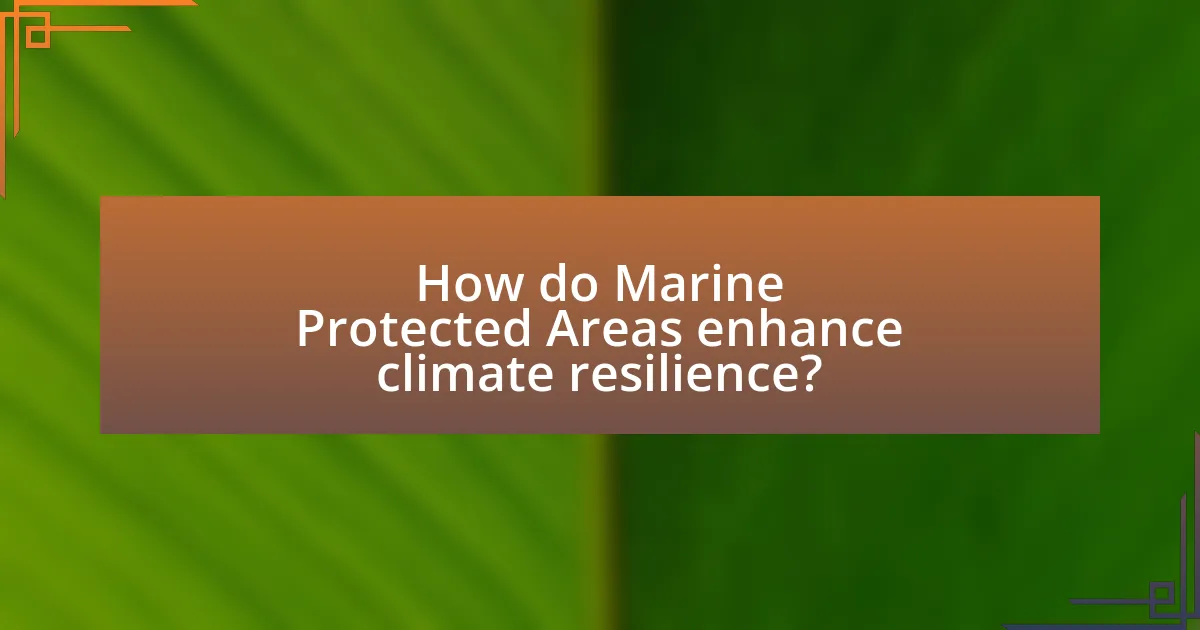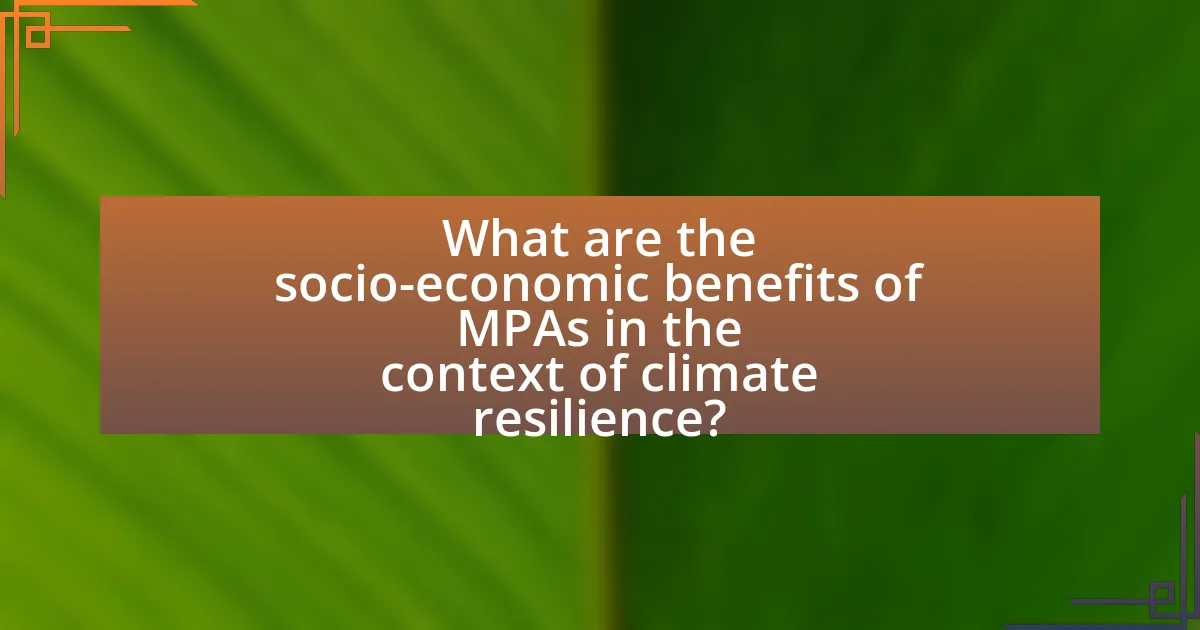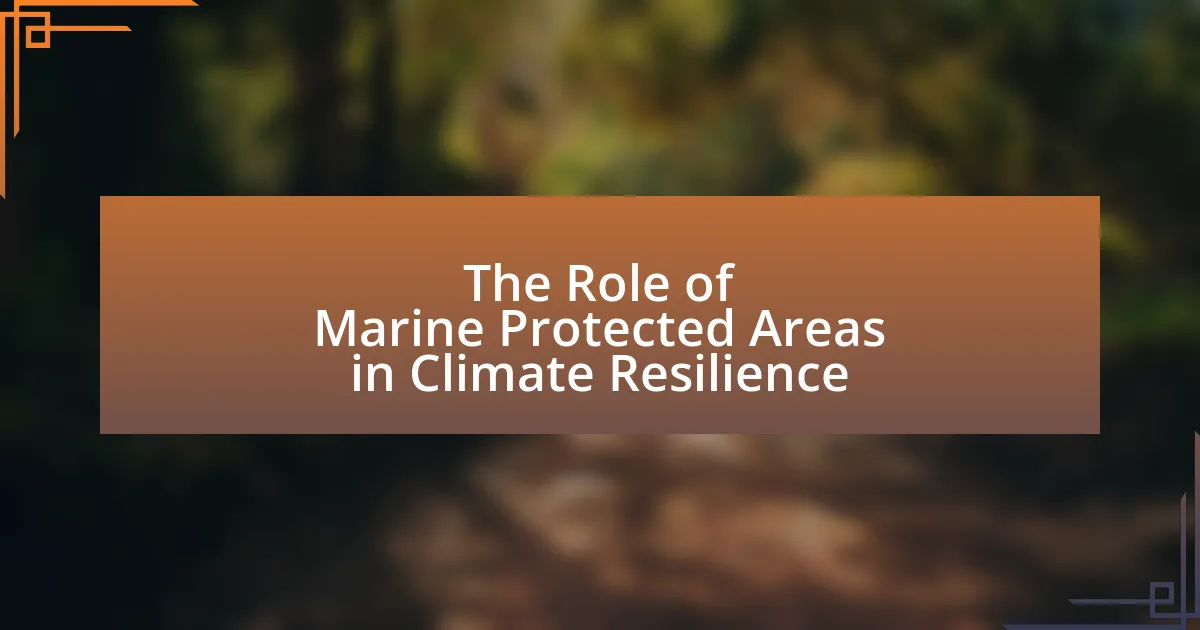Marine Protected Areas (MPAs) are designated regions in marine environments aimed at conserving biodiversity and ecosystems by regulating human activities. This article explores the definition, classification, and criteria for MPAs, highlighting their importance in protecting marine life and enhancing climate resilience. It discusses the various types of MPAs, their role in biodiversity conservation, and their mechanisms for mitigating climate change impacts, including carbon sequestration and protection of coastal communities. Additionally, the article examines the socio-economic benefits of MPAs, the significance of community engagement and governance, and best practices for effective MPA management in the context of climate resilience.
-1.webp)
What are Marine Protected Areas (MPAs)?
Marine Protected Areas (MPAs) are designated regions in marine environments where human activities are regulated to conserve biodiversity and ecosystems. These areas aim to protect marine life, habitats, and cultural resources, often restricting activities such as fishing, mining, and development to promote ecological health. According to the International Union for Conservation of Nature, as of 2021, approximately 7.7% of the world’s oceans are covered by MPAs, highlighting their role in safeguarding marine ecosystems and enhancing resilience against climate change impacts.
How are MPAs defined and classified?
Marine Protected Areas (MPAs) are defined as regions of the ocean where human activity is restricted to protect the natural environment and biodiversity. MPAs are classified based on their level of protection and management objectives, which can range from fully protected areas with no extractive activities to multiple-use areas that allow sustainable fishing and tourism. For instance, the International Union for Conservation of Nature (IUCN) categorizes MPAs into six management categories, from strict nature reserves to protected seascapes, each with specific regulations and conservation goals. This classification system helps in assessing the effectiveness of MPAs in conserving marine ecosystems and enhancing climate resilience.
What criteria are used to designate an area as a Marine Protected Area?
Marine Protected Areas (MPAs) are designated based on criteria that include ecological significance, biodiversity, and the presence of unique habitats or species. Specifically, areas are evaluated for their role in conserving marine ecosystems, protecting endangered species, and maintaining critical habitats such as coral reefs or mangroves. The designation process often involves assessments of the area’s ecological health, the level of human impact, and the potential for recovery or resilience against climate change. For instance, the International Union for Conservation of Nature (IUCN) provides guidelines that emphasize the importance of protecting areas that contribute to the overall health of marine environments, thereby supporting climate resilience.
What types of MPAs exist and how do they differ?
Marine Protected Areas (MPAs) can be categorized into several types, including fully protected areas, no-take zones, and multiple-use MPAs. Fully protected areas prohibit all extractive activities, allowing ecosystems to recover and thrive, while no-take zones specifically ban fishing and resource extraction, focusing on conservation. Multiple-use MPAs permit various activities, such as fishing and tourism, under regulated conditions to balance conservation with human use. These distinctions are crucial for effective management and conservation strategies, as they determine the level of protection and the types of activities allowed, impacting biodiversity and ecosystem health.
Why are MPAs important for marine ecosystems?
Marine Protected Areas (MPAs) are crucial for marine ecosystems because they provide a refuge for biodiversity, allowing species to thrive and recover from human impacts. MPAs help maintain healthy populations of marine life, which in turn supports ecosystem functions such as nutrient cycling and habitat stability. Research indicates that MPAs can increase fish biomass by up to 600% compared to unprotected areas, demonstrating their effectiveness in enhancing marine biodiversity and resilience. Additionally, MPAs contribute to climate resilience by protecting critical habitats like coral reefs and mangroves, which serve as natural buffers against climate change impacts such as ocean acidification and rising sea levels.
How do MPAs contribute to biodiversity conservation?
Marine Protected Areas (MPAs) contribute to biodiversity conservation by providing safe habitats for various marine species, allowing ecosystems to recover and thrive. MPAs restrict human activities such as fishing and pollution, which helps to maintain healthy populations of marine organisms. Research indicates that MPAs can lead to increased species richness and abundance; for example, a study published in “Nature” by Edgar et al. (2014) found that fish biomass was, on average, 2.5 times greater in MPAs compared to non-protected areas. This enhanced biodiversity supports ecosystem resilience, enabling marine environments to better withstand climate change impacts.
What role do MPAs play in protecting endangered species?
Marine Protected Areas (MPAs) play a crucial role in protecting endangered species by providing safe habitats that limit human activities such as fishing, pollution, and habitat destruction. These designated areas help to conserve biodiversity and allow for the recovery of depleted populations. For instance, studies have shown that MPAs can lead to a significant increase in the abundance and diversity of marine life, with some areas reporting up to a 600% increase in fish populations within a few years of establishment. This protection is vital for endangered species, as it enhances their chances of survival and reproduction in a more stable environment.

How do Marine Protected Areas enhance climate resilience?
Marine Protected Areas (MPAs) enhance climate resilience by safeguarding biodiversity and ecosystem functions that are critical for adapting to climate change. MPAs provide a refuge for marine species, allowing populations to recover and maintain genetic diversity, which is essential for resilience against environmental changes. Research indicates that ecosystems within MPAs, such as coral reefs and mangroves, can better withstand and recover from climate-related stressors like ocean acidification and rising sea temperatures. For instance, a study published in “Nature” by Edgar et al. (2014) found that MPAs can increase the resilience of marine ecosystems by up to 50%, demonstrating their effectiveness in mitigating the impacts of climate change.
What mechanisms do MPAs use to mitigate climate change impacts?
Marine Protected Areas (MPAs) mitigate climate change impacts through several mechanisms, including habitat protection, biodiversity conservation, and enhancement of ecosystem services. By safeguarding critical habitats such as coral reefs and mangroves, MPAs help maintain the resilience of marine ecosystems against climate stressors like ocean warming and acidification. Research indicates that well-managed MPAs can enhance fish populations and biodiversity, which in turn supports ecosystem stability and productivity. For instance, a study published in “Nature” by Edgar et al. (2014) found that MPAs can increase fish biomass by an average of 446%, thereby promoting healthier marine environments that are better equipped to withstand climate change effects. Additionally, MPAs contribute to carbon sequestration, as healthy marine ecosystems, particularly seagrasses and mangroves, capture and store significant amounts of carbon dioxide, further mitigating climate change impacts.
How do MPAs help in carbon sequestration?
Marine Protected Areas (MPAs) enhance carbon sequestration by preserving marine ecosystems that capture and store carbon, such as seagrasses, mangroves, and coral reefs. These ecosystems are known to sequester significant amounts of carbon dioxide from the atmosphere; for instance, seagrasses can store up to 83,000 tons of carbon per square kilometer over a century. By protecting these habitats from degradation and overfishing, MPAs maintain their ability to sequester carbon effectively. Research indicates that MPAs can increase the biomass of these carbon-storing organisms, further enhancing their carbon capture capabilities.
What is the role of MPAs in protecting coastal communities from climate-related hazards?
Marine Protected Areas (MPAs) play a crucial role in safeguarding coastal communities from climate-related hazards by enhancing ecosystem resilience and providing natural barriers against extreme weather events. MPAs contribute to the protection of biodiversity, which is essential for maintaining healthy ecosystems that can better withstand climate impacts such as sea-level rise and increased storm intensity. For instance, healthy coral reefs and mangroves, often found within MPAs, act as buffers that reduce wave energy and coastal erosion, thereby protecting shorelines and human settlements. Research indicates that areas with robust marine ecosystems can reduce storm surge impacts by up to 50%, demonstrating the effectiveness of MPAs in mitigating climate-related risks.
Why is the connectivity of MPAs crucial for climate resilience?
The connectivity of Marine Protected Areas (MPAs) is crucial for climate resilience because it facilitates the movement of species and genetic diversity, which enhances ecosystem adaptability to changing environmental conditions. Connected MPAs allow marine organisms to migrate in response to climate stressors, such as temperature changes and ocean acidification, thereby maintaining population viability and ecosystem functions. Research indicates that interconnected networks of MPAs can improve resilience by providing refuge areas and promoting recovery from disturbances, as seen in studies showing that well-connected MPAs support higher biodiversity and ecosystem stability.
How does the design of MPAs affect their effectiveness in climate adaptation?
The design of Marine Protected Areas (MPAs) significantly influences their effectiveness in climate adaptation by determining the ecological resilience and biodiversity they support. Well-designed MPAs that incorporate diverse habitats, such as coral reefs and mangroves, enhance ecosystem services that mitigate climate impacts, such as coastal erosion and flooding. For instance, studies have shown that MPAs with a variety of habitats can better withstand and recover from climate stressors, as they provide refuge for species and maintain genetic diversity. Additionally, the size and connectivity of MPAs are critical; larger and well-connected areas facilitate species migration in response to changing environmental conditions, thereby improving overall resilience. Research indicates that MPAs designed with these factors in mind can lead to a 20-30% increase in biodiversity, which is essential for adaptive capacity in the face of climate change.
What are the challenges in maintaining connectivity among MPAs?
Maintaining connectivity among Marine Protected Areas (MPAs) faces several challenges, including habitat fragmentation, varying management practices, and climate change impacts. Habitat fragmentation disrupts the movement of marine species between MPAs, limiting genetic diversity and resilience. Different management practices across MPAs can lead to inconsistent regulations and enforcement, complicating collaborative conservation efforts. Additionally, climate change affects ocean temperatures and currents, altering species distributions and further complicating connectivity. These factors collectively hinder the effectiveness of MPAs in promoting biodiversity and climate resilience.

What are the socio-economic benefits of MPAs in the context of climate resilience?
Marine Protected Areas (MPAs) provide significant socio-economic benefits that enhance climate resilience by safeguarding marine biodiversity and supporting local economies. MPAs contribute to the sustainability of fisheries, which are vital for food security and livelihoods, by allowing fish populations to recover and thrive, leading to increased catches outside their boundaries. For instance, studies have shown that fish biomass can increase by up to 600% in well-managed MPAs, benefiting local fishers economically. Additionally, MPAs promote eco-tourism, generating revenue and employment opportunities in coastal communities, which can be crucial during climate-related disruptions. The protection of marine ecosystems within MPAs also helps mitigate climate impacts, such as coastal erosion and flooding, by maintaining natural barriers like coral reefs and mangroves, thereby reducing the economic costs associated with climate-related disasters.
How do MPAs support local economies?
Marine Protected Areas (MPAs) support local economies by enhancing fisheries productivity and promoting sustainable tourism. MPAs create safe habitats for marine species, leading to increased fish populations, which benefits local fishers through higher catch rates. For example, studies have shown that fish biomass can increase by up to 600% in MPAs, directly impacting local fishing yields. Additionally, MPAs attract tourists interested in activities like snorkeling and diving, generating revenue for local businesses. In regions like the Caribbean, MPAs have been linked to a 20% increase in tourism revenue, demonstrating their economic value.
What are the potential economic impacts of MPAs on fisheries?
Marine Protected Areas (MPAs) can have significant economic impacts on fisheries by enhancing fish populations and biodiversity, which can lead to increased catch yields outside their boundaries. Studies indicate that MPAs can result in a 20-30% increase in fish biomass within their limits, which often translates to higher fish stocks in adjacent areas due to spillover effects. For instance, research published in “Ecological Applications” by Lester et al. (2009) demonstrated that MPAs in California led to a 50% increase in the abundance of certain fish species, benefiting local fisheries economically. Additionally, MPAs can promote sustainable fishing practices, which can stabilize fish populations and ensure long-term economic viability for fishing communities.
How can MPAs promote sustainable tourism?
Marine Protected Areas (MPAs) can promote sustainable tourism by providing a framework for conservation that enhances biodiversity and ecosystem health, which in turn attracts tourists. MPAs protect marine habitats, such as coral reefs and mangroves, which are vital for marine life and tourism activities like snorkeling and diving. According to a study published in the journal “Conservation Letters,” areas with effective MPAs can see a 20-30% increase in fish populations, leading to more vibrant ecosystems that draw visitors. Additionally, MPAs often implement regulations that limit overfishing and habitat destruction, ensuring that tourism activities do not compromise the natural resources that tourists come to enjoy. This sustainable approach not only preserves the environment but also supports local economies reliant on tourism, creating a balance between ecological integrity and economic benefit.
What role do community engagement and governance play in the success of MPAs?
Community engagement and governance are critical for the success of Marine Protected Areas (MPAs) as they foster local stewardship and ensure compliance with regulations. Effective governance structures that involve local communities lead to better management practices, as stakeholders are more likely to support and adhere to conservation efforts when they have a voice in decision-making. Research indicates that MPAs with strong community involvement report higher levels of compliance and improved ecological outcomes, such as increased fish populations and biodiversity. For instance, a study published in “Conservation Biology” by Charles et al. (2016) found that community-led MPAs in the Philippines showed significantly better ecological health compared to those without local engagement. This evidence underscores the importance of integrating community perspectives and governance frameworks to enhance the effectiveness of MPAs in promoting climate resilience.
How can local communities be involved in MPA management?
Local communities can be involved in Marine Protected Area (MPA) management through participatory governance, where they contribute to decision-making processes. This involvement can include co-management agreements that empower local stakeholders to take an active role in conservation efforts, ensuring that their traditional knowledge and practices are integrated into management strategies. Research indicates that when local communities are engaged, such as in the case of the Great Barrier Reef Marine Park Authority, conservation outcomes improve due to increased compliance and stewardship. Additionally, community-led monitoring programs can enhance data collection and resource management, leading to more effective protection of marine ecosystems.
What governance structures are most effective for MPAs?
Effective governance structures for Marine Protected Areas (MPAs) include collaborative management, adaptive governance, and community-based approaches. Collaborative management involves partnerships between government agencies, local communities, and stakeholders, which enhances compliance and stewardship. Adaptive governance allows for flexibility in management practices based on ecological changes and stakeholder input, ensuring that MPAs can respond to environmental shifts. Community-based approaches empower local populations to take an active role in the management and protection of marine resources, leading to increased local support and sustainable practices. Research indicates that MPAs with these governance structures are more successful in achieving conservation goals and enhancing resilience to climate change impacts. For instance, a study published in “Marine Policy” by Gelcich et al. (2010) highlights that MPAs with strong community involvement show improved ecological outcomes and greater compliance with regulations.
What best practices can enhance the effectiveness of MPAs for climate resilience?
Implementing adaptive management strategies enhances the effectiveness of Marine Protected Areas (MPAs) for climate resilience. Adaptive management allows for ongoing assessment and modification of management practices based on ecological changes and scientific research, ensuring that MPAs can respond effectively to climate impacts. For instance, a study published in “Conservation Letters” by C. M. Roberts et al. (2017) highlights that MPAs employing adaptive management showed improved biodiversity and ecosystem health, which are crucial for resilience against climate change. Additionally, integrating local community involvement in decision-making processes fosters stewardship and compliance, further strengthening the resilience of MPAs.
How can monitoring and evaluation improve MPA management?
Monitoring and evaluation can significantly improve Marine Protected Area (MPA) management by providing data-driven insights that inform decision-making. Effective monitoring allows for the assessment of ecological health, biodiversity, and the effectiveness of conservation strategies within MPAs. For instance, studies have shown that regular monitoring can identify trends in fish populations and habitat conditions, enabling managers to adapt strategies in response to environmental changes or human impacts. Evaluation processes help determine whether management objectives are being met, facilitating adjustments to policies and practices based on empirical evidence. This iterative process enhances the resilience of marine ecosystems, ultimately contributing to the overall effectiveness of MPAs in mitigating climate change impacts.
What strategies can be implemented to increase public awareness and support for MPAs?
To increase public awareness and support for Marine Protected Areas (MPAs), targeted education campaigns and community engagement initiatives should be implemented. These strategies can include organizing workshops, informational sessions, and interactive events that highlight the ecological and economic benefits of MPAs, such as biodiversity conservation and sustainable fisheries. Research indicates that communities involved in the management of MPAs are more likely to support them; for instance, a study published in “Conservation Biology” by Charles et al. (2015) found that local stakeholder involvement significantly enhances the perceived value of MPAs. Additionally, leveraging social media platforms to disseminate success stories and scientific data can further amplify public interest and support.
